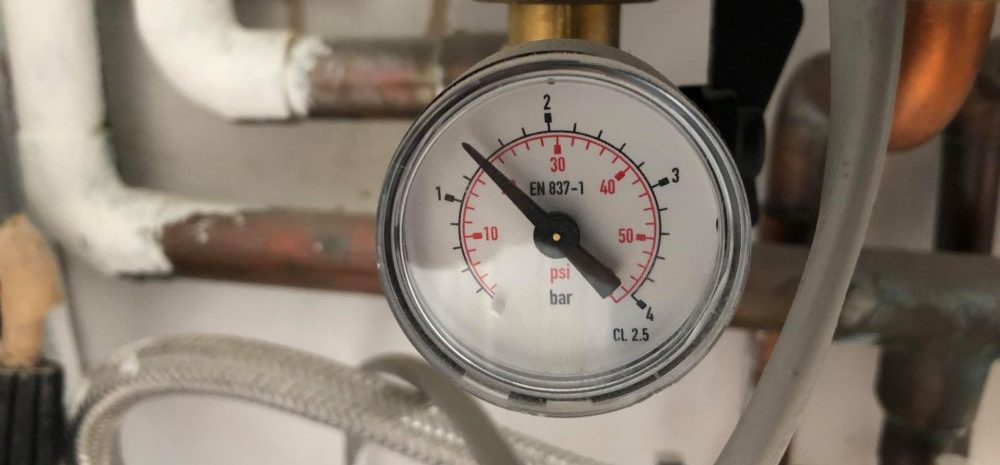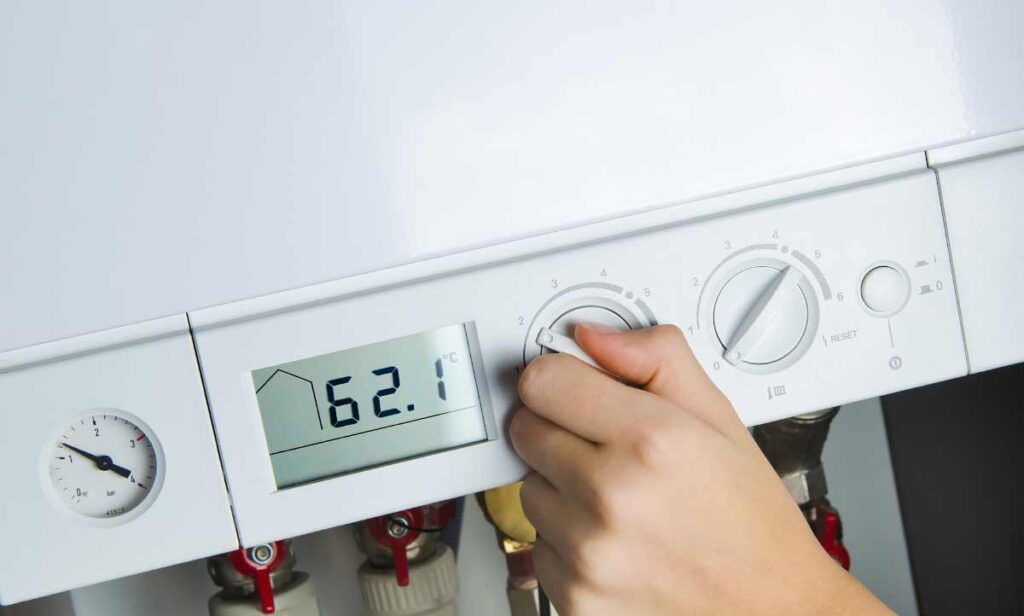Boiler pressure might not be the most exciting topic, but it’s one you can’t ignore if you want your heating system running smoothly. The right pressure keeps hot water flowing and your home comfortable.
Too high or too low, and you’re looking at cold showers or costly repairs. This guide clears up the numbers and shows you what to do.
What Should Boiler Pressure Be?
Boiler pressure should sit between 1 and 2 bar when cold, rising slightly when hot but not past 2.5 bar.
Key Takeaway
- Ideal boiler pressure: 1–2 bar when cold
- Slight rise when heating, but keep it under 2.5 bar
- Too low = weak heat and lukewarm showers
- Too high = leaks, stress, and costly repairs
- Fixes: Top up with filling loop (low) or bleed a radiator (high)
- Call a pro if pressure keeps dropping or rising
What Is Boiler Pressure?

Boiler pressure is simply the force that pushes hot water through your heating system. Think of it as the blood pressure of your boiler. Too low and your radiators won’t heat properly. Too high and you risk leaks or damage.
You can usually find the pressure displayed on a dial at the front of your boiler. Most modern models highlight a green zone for optimal levels, making it simple to check at a glance — another reason why boiler maintenance is important for keeping your system running smoothly.
If it’s sitting outside that sweet spot, don’t panic. Adjusting pressure is usually straightforward, and your manual will walk you through it. Keeping it in range means your heating runs smoother, uses less energy, and saves you future headaches.
Why Boiler Pressure Matters
Boiler pressure isn’t just a number on the gauge, it’s the heartbeat of your heating system. If it’s too low, your radiators stay cold and showers turn lukewarm. Too high, and you’re stressing the system like a tire about to blow.
Keeping it in the sweet spot means steady heat, lower bills, and fewer surprise repairs. Think of it as keeping your car’s tyres at the right PSI. You get smoother rides, better efficiency, and no breakdowns on the way to work.
The fix? Check your pressure regularly and adjust before it snowballs into a problem. A quick top-up or release now saves you cash and hassle later—and if issues keep coming back, scheduling a professional boiler repair can help prevent bigger headaches down the line.
What Should Boiler Pressure Be?
Your boiler’s pressure isn’t guesswork, it’s a sweet spot. For most modern systems, that magic number sits between 1 and 2 bars when cold. Fire it up and you’ll see it rise slightly, but it shouldn’t cruise past 2.5.
If the gauge dips below 1, your boiler’s struggling, which means weak heat and lukewarm showers. Too high, and you’re stressing the system like a car stuck in a redline.
The quick fix? Top it up with the filling loop if it’s low. If it’s high, bleed a radiator to release some pressure. Easy tweaks keep things balanced without calling in backup.
Bottom line: keep your boiler in that 1–2 bar zone, and you’ll avoid most headaches. Think of it as the difference between a steady beat and a blown speaker.
Low Boiler Pressure: Causes and Fixes
Low boiler pressure is like weak Wi-Fi: annoying, but fixable. It usually happens from small leaks, recent radiator bleeding, or just everyday wear. The pressure gauge will dip under 1 bar, and you’ll notice lukewarm showers or slow-to-heat radiators.
The quick fix? Use your boiler’s filling loop to bring it back up to the 1–1.5 bar range. If the pressure drops again quickly, it’s often a sign of a hidden leak or faulty valve. In cases like this, it’s worth understanding how is a hot water boiler pressure relief valve tested?—because simply topping it up on repeat is only a temporary band-aid, not a real solution.
Check around for visible drips or water patches. If nothing shows, call a pro before it snowballs into bigger damage. Think of it like topping off oil in your car: fine now and then, but if it keeps disappearing, you’ve got a bigger story to deal with.
High Boiler Pressure: Causes and Fixes
If your boiler’s pressure gauge is creeping past 2.5 bar, that’s not just extra muscle, it’s a warning sign. High pressure usually comes from a recently topped-up system, a faulty pressure relief valve, or too much water stuck inside.
First move? Check if you accidentally left the filling loop open. If that’s fine, bleed a radiator to release some water and bring the pressure back to earth.
Still running high? The expansion vessel might be the culprit, which means calling a pro. Don’t ignore it though, because constant high pressure can stress your system and shorten its life.
Bottom line: handle the easy fixes yourself, but if the gauge keeps flexing past normal, get a technician in before it snowballs into a bigger repair.
How to Check Boiler Pressure
Checking boiler pressure is easy and takes less than a minute. Look at the pressure gauge on the front of your boiler. When the system is cold, it should sit around 1 to 1.5 bar.
If it’s running, expect it to climb closer to 2 bars. Too high or too low? That’s your cue to either top it up with the filling loop or bleed a radiator to bring it back in range.
How to Adjust Boiler Pressure Safely
First, check the gauge. If it’s low, find the filling loop (usually a small silver hose) and slowly open the valve until the needle hits the sweet spot, around 1–1.5 bar.
If the pressure’s too high, bleed a radiator with a radiator key to let off some water and bring it back down.
Move slow and steady when handling your system. Overfilling or draining too much can throw things off—think of it like mixing a cocktail, balance matters more than excess. And if balance ever slips, reliable services like boiler repair in East Providence can help get things back on track.
When to Call a Professional

If your boiler pressure keeps dropping or climbing no matter what you do, it’s time to call in the pros. Strange noises, water leaks, or error codes flashing on the display aren’t DIY fixes.
A qualified engineer can spot hidden issues fast and save you from bigger, pricier headaches. Think of it like knowing when to stop Googling symptoms and actually seeing a doctor—you’ll thank yourself later.
Frequently Asked Questions
1. What’s the ideal boiler pressure?
You want it sitting between 1 and 2 bars when the system’s cool. Anything lower and it struggles, anything higher and you’re stressing the parts.
2. Why does my pressure keep dropping?
Usually it’s a sneaky leak or trapped air in the system. A quick top-up with the filling loop often does the trick, but if it keeps happening, call in a pro.
3. Is high pressure dangerous?
Not instantly, but it’s not a flex either. Over time it can wreck seals and valves, so bleed a radiator or get a tech to check it.
Conclusion
Boiler pressure isn’t rocket science, but it makes or breaks your heating game. Aim for that sweet spot between 1 and 2 bars. If it’s too low, top it up, and if it’s too high, bleed the radiators.
Simple tweaks keep your system running smoothly, save you cash, and stop those “why’s the shower freezing?” mornings.
Think of it like keeping your sneakers clean, regular checks mean less stress and way more comfort.